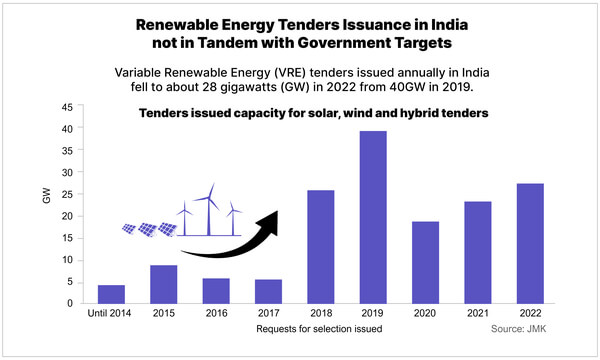India needs to increase renewables tender issuance to meet clean energy targets
Variable renewable energy tenders issued annually in India have fallen from 40 gigawatts (GW) in 2019 to about 28GW in 2022. This is below the level required for India to achieve its target of 450GW of installed renewable energy capacity by 2030, finds a new joint report from the Institute for Energy Economics and Financial Analysis (IEEFA) and JMK Research & Analytics.
“Currently, renewable energy tendering activity is off-track. To reach the 2030 target, India will need to open renewables tenders for at least 35GW annually,” says the report’s co-author Vibhuti Garg, Director, South Asia, IEEFA.
“But with tendering authorities looking to design tenders that balance the needs of the developers and the electricity distribution companies (DISCOMs), more than 35GW per year, although ambitious, is attainable. It is now important that Solar Energy Corporation of India (SECI), NTPC and state agencies deploy their tendering experience to implement viable and innovative tenders in the renewable energy space.
“Other nations are looking to emulate India’s renewables success story – this is an opportunity to increase tender activity in domestic, deflationary and zero-emissions electricity capacity expansions to diversify and strengthen the grid system,” she adds.
The report finds that the fall in annual tender issuance is due to a combination of factors, including the shift in the preference of state electricity distribution companies (DISCOMs) away from plain vanilla solar and wind projects. Instead, DISCOMS want firm power from sources like wind-solar hybrid or renewables coupled with energy storage.

Image: IEEFA
Overly aggressive bidding by developers have increased their cost pressures and as a result their interest in recent tenders has waned.
“Aggressive bidding and a failure to foresee a 30-40% rise in solar module prices have slowed developer participation due to the unviable prices that some reverse auctions discover. The central government has shown the way by planning to remove reverse auctions in wind tenders and instead stick to a traditional round of closed bidding,” says the report’s co-author Prabhakar Sharma, Consultant, JMK Research.
In a traditional closed auction, developers just make one bid in one round. This is not visible to other bidders. The lowest tariff quoted wins the auction. There are no further rounds to drive down the tariff.
The poor financial health of DISCOMs, leading to payment dues and renegotiation of already executed contracts in certain states, is also discouraging developers from participating in tenders.
“To address this issue, payment security mechanisms need strengthening. This would assuage developers’ fears of delayed payments,” says Sharma.
State-level tendering activity has also slowed down due to various reasons. While some states have already achieved their renewable purchase obligation (RPO) targets, others continue to rely on conventional thermal power.
“Renewable energy-rich states like Karnataka and Andhra Pradesh have already achieved their RPO targets. Hence, tender issuance from these states has slowed significantly despite the still-free interstate grid transmission access for variable renewable energy. Further, given that some of the tariffs discovered in the recent ‘new-age’, round-the-clock renewables tenders are on the higher side, some DISCOMs continue to stay away from renewable energy,” says Sharma.
The report recommends strict enforcement of RPO targets and heavy penalties for failures to increase the pace of state-level tender issuance.
It also says pooled tariffs, implemented during certain control periods, would allay the DISCOMs’ fear of missing out on lower renewable energy tariffs in the future and hence address the delays in signing power supply agreements (PSA).
If electricity sector stakeholders take steps to fix the combination of factors behind the slowdown, achieving more than 35GW of annual tendering will be possible, says Garg.
Read the report: Renewable Energy Tenders Issuance in India Not in Tandem With Government Targets
- Source:
- IEEFA
- Author:
- Press Office
- Link:
- ieefa.org/...
- Keywords:
- IEEFA, JMK, analysis, report, India, renewable energy, target, clean, government, GW, level, energy, tender, developer
























